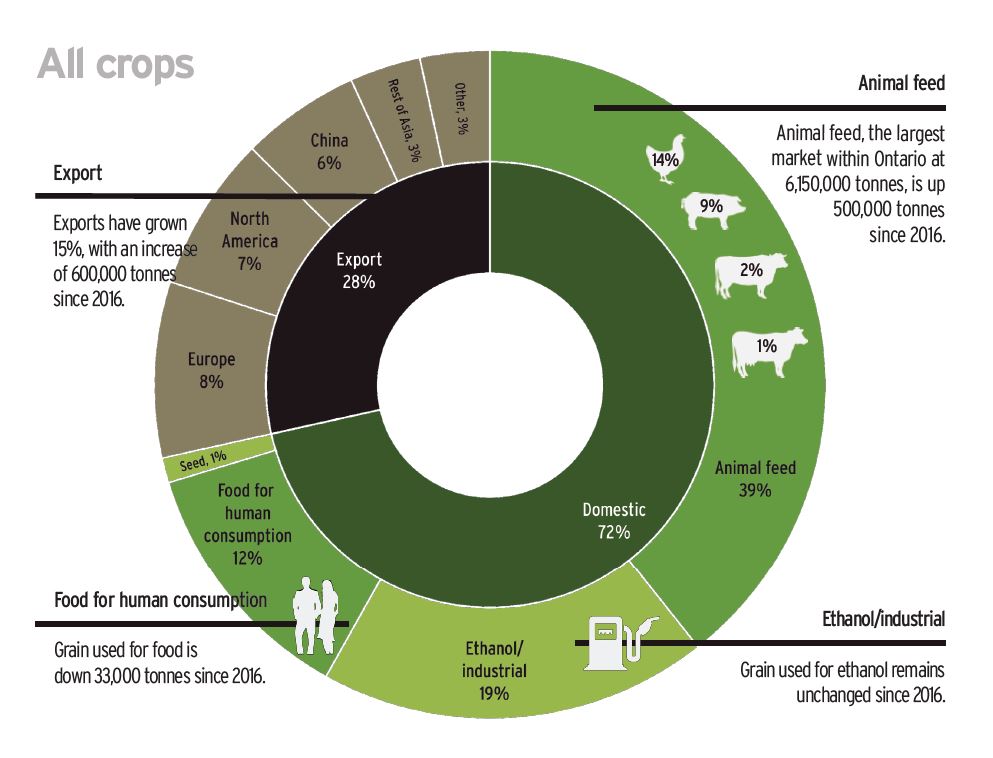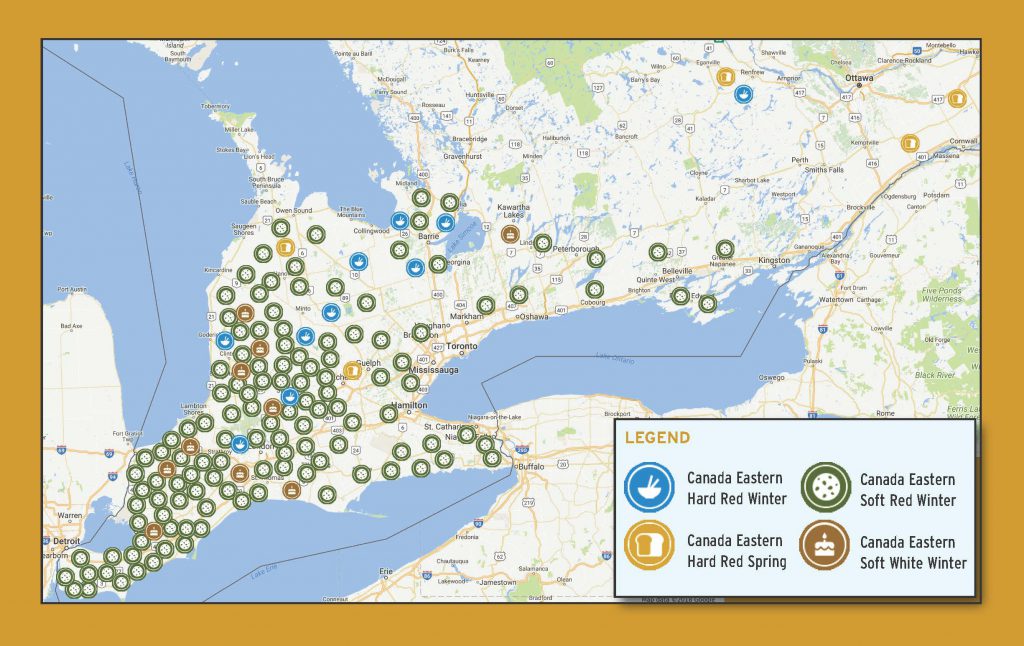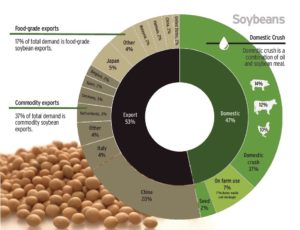The Whole Grains Story – #WhereDoGrainsGo Campaign
Agriculture is an important economic driver for the province of Ontario. From 2016-2018 more than 15 million metric tonnes of barley, corn, oats, soybeans, and wheat were produced on six million acres of land. This generated over $18 billion in economic output and were responsible for over 75,000 jobs in the province.
One question that we find we get quite often when we attend events is where do Ontario grains go after they’ve been harvested?
It can be complicated to figure out exactly where everything is going when there are 28,000 farmers working year-round to produce millions of tonnes of grain crops – some of it is shipped to other provinces or exported around the world, some of it is used on-farm to feed livestock, and most of it goes to the same ports and terminals that western Canadian grain travels through, so trying to track where grains go can be difficult.
Read more about #WhereDoGrainsGo with the following posts on each of Ontario’s five grains:
Click through the tabs:
Wheat is the third largest field crop in Ontario and each year Ontario produces on average, 2.3 million metric tones of wheat on 1 million acres.
Ontario produces two different categories of wheat: winter and spring wheat.
Within each category there are several different classes including: soft red winter, soft white winter, hard red winter, and hard red spring.
Each category of wheat grown is used for different uses and is best suited to certain climates and the flour from the four classes of wheat we grow are best suited to a particular type of food product.
- Canada Easter Hard Red Winter Wheat is commonly used to make flat breads or noodles.
- Canada Eastern Soft Red Winter Wheat is used to make cookies and cereals.
- Canada Eastern Hard Red Spring Wheat is used to make breads.
- Canada Eastern Soft White Winter Wheat issued to make cakes and pastries.
These varieties are classified based on their colour (red or white), hardness due to protein amount (hard or soft) and their growing season (winter or spring).
Did you know Ontario is the leading corn producing province in the country – growing on average, 62% of Canada’s grain corn?
Grain corn is the second largest crop in terms of acreage in Ontario, but it is the largest volume crop – farmers produce on average, 8.7 million metric tonnes a year on 2.1 million acres.
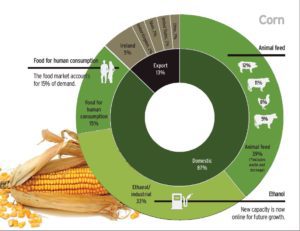
For anyone that has drove past farmers fields- you might have noticed this – there is A LOT of corn in the province!
In terms of global corn production, Canada is a minor player: producing only 1% of the global corn supply. Most of the corn grown globally is driven by the United States, China, and South America.
87% of Ontario produced corn is used right here in Ontario! Most of Ontario’s domestic grain corn is used in swine, beef, poultry, and dairy feed.
Interestingly, after corn has been processed into food, ethanol, whisky etc., the byproducts or leftover pieces of corn are actually sold as animal feed as well. These are called dried distillers grains, and a great way to reduce food waste from the processing side of the industry. Ethanol production and other industrial applications, including industrial alcohols and oils is also a large use for domestic corn.
Food for human consumption is also an important market for domestic corn. Grain corn can be found in many foods such as corn chips, tortillas, whiskey, yogurt, bread, and more!
Ontario corn is exported to markets in the United States, Spain, the Republic of Ireland, and the United Kingdom, and exports have been increasing over the past three years. Export markets provide an increasingly large opportunity as production and yields are continually improving in Ontario.
Barley and oat production in Ontario is relatively small compared to other grain commodities. On average, 113,000 metric tonnes of barley are produced on 91,000 acres each year, and 74,000 metric tonnes of oats are on 75,000 acres.
Ontairo use for barley
Did you know that all of the barley that is produced in Ontario is used locally?
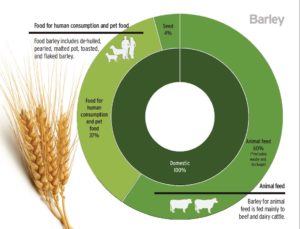
60% of the barley grown is mostly used in animal feed for beef and dairy cattle.
Barley is also used in food for human consumption and pet food – or about 37% of the barley harvested each fall. Food for human consumption includes de-hulled, pearled, toasted, and barley flakes.
From there this barley can be used in soups, breads, cereals or sold as whole grain barley in the grocery store! There is also a small percentage of barley grown specifically for seed.
Barley can also be grown as malt barley for craft breweries. This isn’t as common for Ontario’s barley, but barley is one of the main ingredients for beer worldwide.
Ontario use of oats
Most of the oat that are produced in Ontario stay in Ontario (64%).
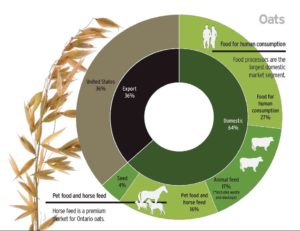
The majority of domestically used oats are used in food for human consumption. Most of these oats are ground to produce oat flakes and flours to be used in cereals and cereal bars.
Fun Fact: most of Ontario oats that are grown for food are actually produced in Northern Ontario! The climatic conditions in Northern Ontario produce a higher quality oat more suitable for the milling industry.
Did you know that oats are also used to make pet food and horse feed? And that horse feed is a premium market for Ontario oats? The high-quality oats will be sold at a premium or higher cost to be made into horse feed.
Domestically used oats are also used in animal feed for beef and dairy calves.
If Ontario oats are not used domestically, they are exported to the United States where they are used in animal feed (36% of total oat demand). Exports to the United States increased by 15% from 2016-2019.
Soybeans are the largest field crop in Ontario and on average, 3 million acres are planted each year producing 3.8 million metric tonnes.
Did you know that Ontario is also the largest producing province of soybeans in Canada, and that Ontario farmers grow 57% of Canada’s total soybean production?
Over the past three years, Ontario soybean production, or the amount grown has increased by 10%. But, in terms of the amount of soybeans grown worldwide, Canada (and Ontario) is a very minor player. Most of the global soybean production is grown by the United States and South America.
Ontario has been producing two categories of soybeans for over 20 years. Ontario produces genetically modified (GM) soybeans (commodity soybeans) that are used in the crush market (75% of production), as well as non-GM food-grade soybeans that are exported and used in various soy food (25% of production).
The crush market is when the soybeans are crushed, the oil and proteins extracted, and then this oil and proteins are used to make a variety of food and nonfood items. Mayonnaise, crayons, candles, car parts are made from soybean oil and many soybean proteins are added into foods, fibres, textiles and even plywood!
Food-grade soybeans are used in a variety of different soy food applications including tofu, miso, natto, and soy beverages.
Exports
Unlike barley, corn, oats, and wheat, the majority of Ontario soybeans are exported; 53% of Ontario’s soybeans destined for international markets. In fact, it is estimated that out of every 5 rows of soybeans grown, 3 rows actually leave Ontario for international markets.
Commodity soybeans are the most exported soybean that is produced in Ontario. Most commodity soybeans are exported to China, the European Union, and the United States. Food-grade soybeans are exported to markets in mostly Asian countries including Japan, Malaysia, and Vietnam.
Ontario Use
Ontario produced soybeans that remain in Ontario are used predominately in animal feed. The main feed markets are swine, dairy cattle, and poultry followed by a very small percentage used in beef cattle.
Soybean oil is another large market for domestic soybeans. Soybean oil uses include food service (restaurants), food manufacturing, retail, vegetable oil, and industrial uses (such as biodiesel).
What isn’t used for animal feed or oil is used for seed purposes and on farm usage.
~Good in Every Grain~
February 26, 2018
A public outreach campaign by Grain Farmers of Ontario.

